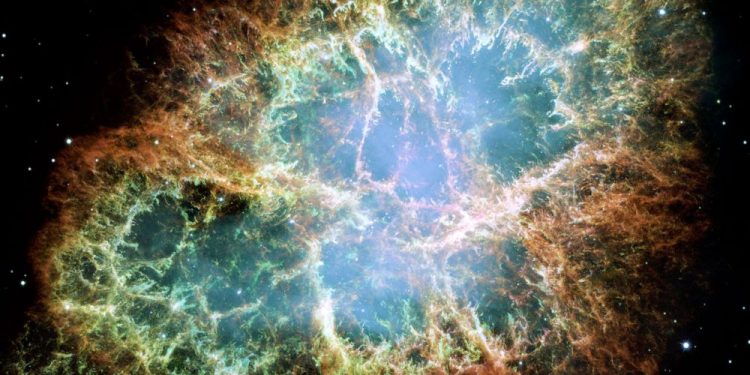The Universe is home to truly gigantic objects. Planets, stars, galaxies, and clusters of galaxies – each of these can be so huge that, compared to them, our solar system with its eight planets is a small insect in a huge forest.
Thanks to modern technology and the latest super-powerful telescopes, astronomers discover dozens of new comets, planets, stars, and other space objects every year.
Many phenomena dazzle the imagination with their properties and dimensions and we have selected some of the largest known objects in the universe that you may have never heard about.
Note: The objects listed below are by no means placed in order based on their size.
1. UY Scuti – Largest Star
We used to think that our Sun is incredible in size. And this is so if we compare it with the Earth: the radius of our star is 109 times larger than that of the Earth and is equal to 696,000 kilometers. Now multiply this value by 1,708 and you get the radius of UY Scuti, which is a star “just” 9,500 light-years away from us. Moreover, at the peak of the pulsations, which is about 740 days, the radius of this celestial body can reach 1,900 solar radii.
For comparison: the volume of UY Scuti is about five billion times the volume of the Sun, and if someone had placed it in the center of our solar system, then the edge of the star would extend just beyond the orbit of Jupiter. The gas and dust emanating from it would scatter even further, beyond the orbit of Pluto or at a distance of about 400 times the distance from the Earth to the Sun. UY Scuti is not only the largest known star but one of the brightest and fastest-burning stars.
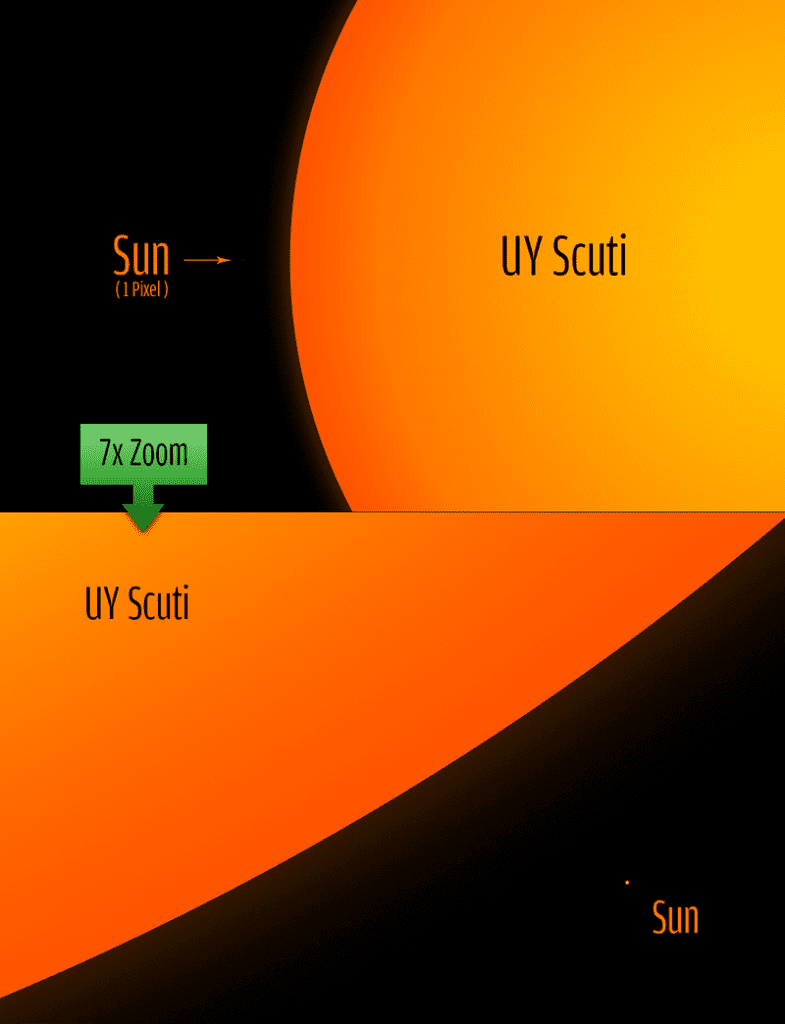
2. NGC 2070 – Largest Nebula
Also called the Tarantula, NGC 2070 is the largest nebula known. It belongs to a satellite galaxy of the Milky Way – the Large Magellanic Cloud, 170,000 light-years away from us.
“Tarantula” is a real nursery of celestial bodies: young stars are born in its clouds of gas and dust. Some of them explode into supernovae, causing the bubbles to be illuminated by X-rays. In the center of the nebula is a kind of cosmic maternity hospital – a small cluster of stars R136, whose age is estimated at about two million years.

3. IC 1101 – Largest Galaxy
By the standards of spiral galaxies, our Milky Way is not impressive in size: 100,000 light-years from edge to edge is an average size. For comparison, IC 1101 is a supergiant elliptical galaxy in the center of the Abell 2029 galaxy cluster and spans six million light-years across. It is 60 times larger and 2,000 times more massive than the Milky Way.
If IC 1101 were in the place of our galaxy, it would have swallowed up the Large and Small Magellanic Clouds, the Andromeda Nebula, and the Triangulum Galaxy. IC 1101 was formed by a collision of galaxies the size of the Milky Way and the Andromeda Nebula.
4. Caelum – Largest Supercluster
You probably know that there is a lot of free space in the cosmos. In fact, most of it is empty. Galaxies and celestial objects are not distributed evenly but exist in something called clusters. In an identical way, there are also massive superclusters like Caelum which is by far the largest known to science.
It spans more than 900 million light-years across and is home to more than 500 million galaxies.
5. Eridanus Supervoid – The CMB Cold Spot
Astronomers have observed many voids in the past but the Supervoid in Eridanus stands out with its size. It spans 1.8 billion light-years across and scientists have no explanation as to how it formed.
It is good to know that supervoids are not actually empty as the name suggests but they have less cosmic material than the typical cosmic area. This supervoid, for example, baffles scientists with its emptiness as it has about 20% less cosmic material than it would be expected.
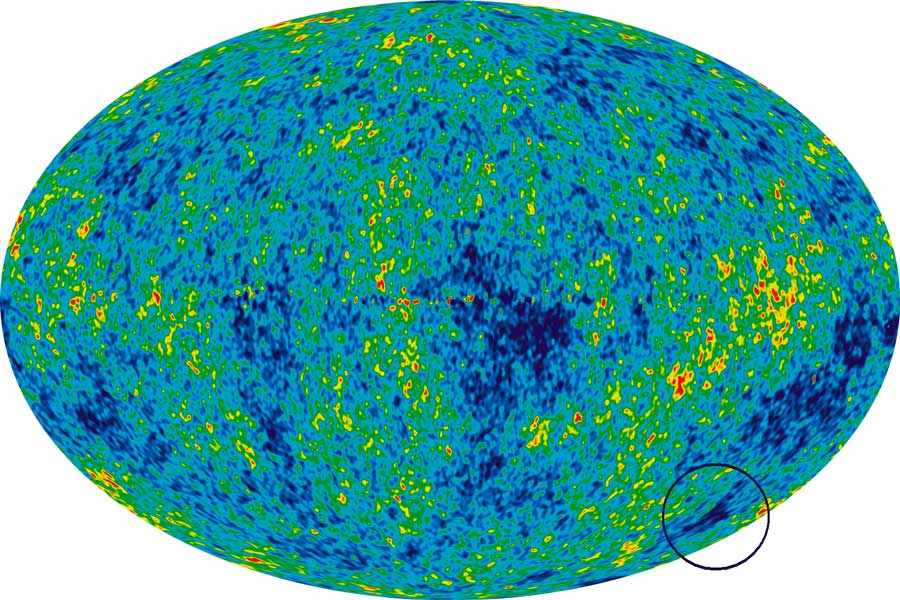
6. TON 618 – Largest Black Hole
How big can black holes become? We surely know that they can be at least as large as TON 618. Almost every galaxy out there has a supermassive black hole in the middle with masses that make our Sun look like a small toy star.
Scientists discover numerous new supermassive black holes every year but for years, the largest known black hole has been TON 618, located in a distant quasar with the same name. Research and observations have concluded that the black hole in the quasar must have a mass of 66 billion solar masses. Scientists, however, expect to find even larger black holes in the near future.
7. Shapley Supercluster – Largest Concentration of Galaxies
The Shapley Supercluster is directly connected to our Milky Way in a very curious way. Scientists have known for decades that our galaxy is being attracted towards a distant part of the universe but it took many years before they could locate the source of attraction.
Containing more than 8000 galaxies and with a mass of about 10,000 Milky Ways, the Shapley Supercluster is the largest concentration of galaxies known to science and it is attracting our own at a speed of 2.2 million kilometers per hour.
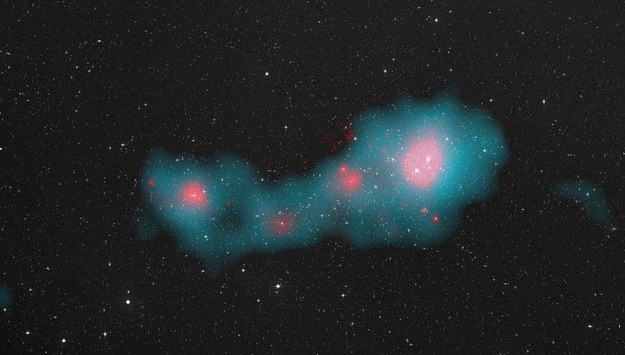
8. SDSS J0 + 2802 – Largest Quasar
In 2015, scientists from the University of Arizona discovered the largest quasar at the edge of the visible universe, located near a supermassive black hole. The object was named SDSS J0 + 2802. For the first time, quasars were discovered in the middle of the last century, and these are the brightest objects in the Universe, which are formed after the end of the life cycle of a star. The end of the life cycle of a star can follow two scenarios. It can shrink to the size of a superdense star or expand to become a quasar.
The discovered quasar has more than one hundred thousand solar masses and is powered by a giant black hole. Scientists not only studied the quasar itself but also measured the mass of the black hole located next to it. The object is located more than 6 million light-years from the earth.
9. GQ Lupi b – Largest Exoplanet
Before we discuss GQ Lupi b, I need to mention that there are other possible candidates for this title but this remains unconfirmed.
The mysterious object GQ Lupi b, which is about 500 light-years from the Sun, was discovered by scientists in 2005 with the VLT (Very Large Telescope) telescope at the Paranal Observatory in Chile.
The problem is that GQ Lupi b is in orbit about two and a half times farther than Pluto from the Sun, and appears to be either a planet or a brown dwarf (essentially a small star).
There is no clarity to this day, but most astronomers tend to consider GQ Lupi b as an exoplanet. The celestial body has a radius of about 3.5 times the radius of Jupiter – the largest planet in our system, but it will shrink as it evolves.
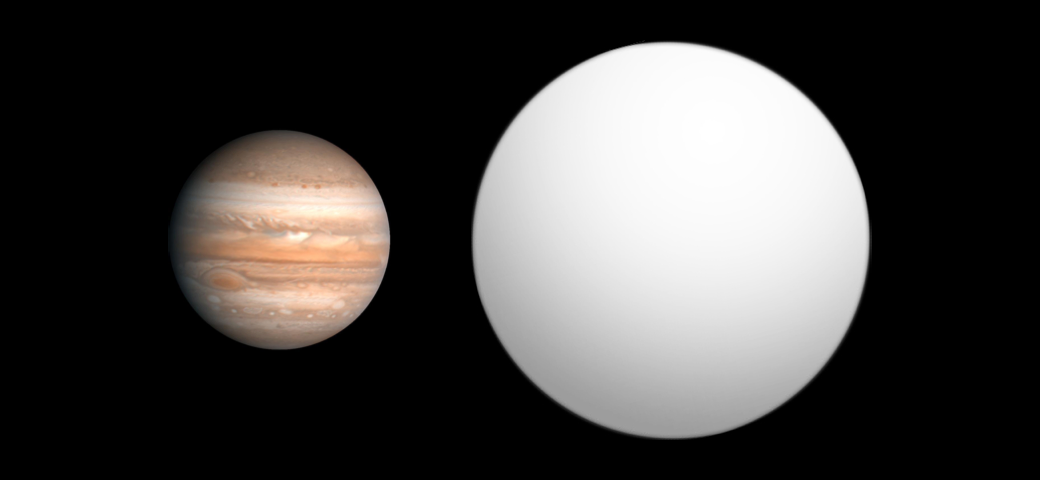
10. Hercules-Corona Borealis Great Wall – Largest Structure
The largest planets, stars, and galaxies are certainly a good thing, but what about something really huge? Meet the Hercules-Corona Borealis Great Wall – the largest known object in the universe.
It is a huge flat superstructure of galaxies over ten billion light-years across, accounting for about 10% of the diameter of the entire universe. The largest structure was discovered in November 2013 based on the results of observations of gamma-ray bursts.
Join the discussion and participate in awesome giveaways in our mobile Telegram group. Join Curiosmos on Telegram Today. t.me/Curiosmos
Sources:
• Caelum Supercluster – Wikipedia. (2021, January 04).
• Choi, C. (2020, September 18). ‘Stupendously large’ black holes could grow to truly monstrous sizes.
• Diodati, M. (2020, April 11). IC 1101, the Largest of All Galaxies.
• GQ Lupi b – Wikipedia. (2020, November 12).
• Hercules–Corona Borealis Great Wall – Wikipedia. (2021, January 16).
• Jones, J. (2019, January 06). 10 Largest Objects in the Universe.
• Mann, A. (2019, October 04). Cosmic Record Holders: The 12 Biggest Objects in the Universe.
• McCracken, J. (n.d.). Next Stop: Voids.
• NGC 2070 – Wikipedia. (2021, January 19).
• Redd, N. (2018, July 26). What Is the Biggest Star?
• Shapley Supercluster.
• Wide-field view of the Tarantula Nebula and its surroundings (ground-based image).
• Wu, X., Wang, F., Fan, X., Yi, W., Zuo, W., Bian, F., . . . Beletsky, Y. (2015, February 25). An ultraluminous quasar with a twelve-billion-solar-mass black hole at redshift 6.30.



